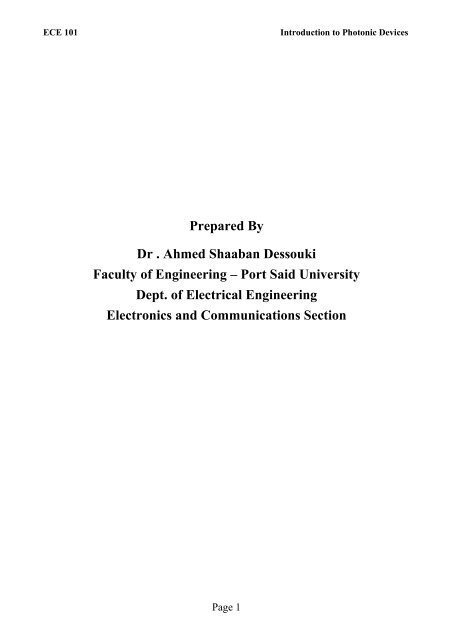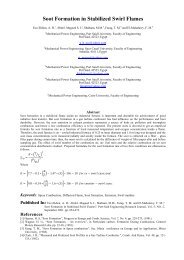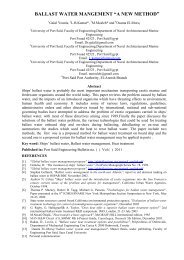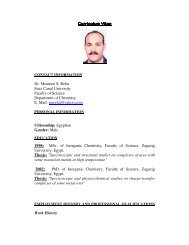Prepared By Dr . Ahmed Shaaban Dessouki Faculty of Engineering ...
Prepared By Dr . Ahmed Shaaban Dessouki Faculty of Engineering ...
Prepared By Dr . Ahmed Shaaban Dessouki Faculty of Engineering ...
You also want an ePaper? Increase the reach of your titles
YUMPU automatically turns print PDFs into web optimized ePapers that Google loves.
ECE 101<br />
Introduction to Photonic Devices<br />
<strong>Prepared</strong> <strong>By</strong><br />
<strong>Dr</strong> . <strong>Ahmed</strong> <strong>Shaaban</strong> <strong>Dessouki</strong><br />
<strong>Faculty</strong> <strong>of</strong> <strong>Engineering</strong> – Port Said University<br />
Dept. <strong>of</strong> Electrical <strong>Engineering</strong><br />
Electronics and Communications Section<br />
Page 1
ECE 101<br />
Introduction to Photonic Devices<br />
Chapter (4): Introduction ِ<br />
to Optoelectronic Devices<br />
4.1 Introduction<br />
Optoelectronics is the term for combined technologies <strong>of</strong> optics and<br />
electronics.<br />
Optoelectronic devices are devices that emit or detect optical radiation. They<br />
considered electrical-to-optical or optical-to-electrical transducers, or instruments that<br />
use such devices in their operation.<br />
Optoelectronics has become an important part <strong>of</strong> our lives. Wherever light is<br />
used to transmit information, tiny semiconductor devices are needed to transfer<br />
electrical current into optical signals and vice versa. Examples include light-emitting<br />
diodes in radios and other appliances, photodetectors in elevator doors and digital<br />
cameras, and laser diodes that transmit phone calls through glass fibers. Such<br />
optoelectronic devices take advantage <strong>of</strong> sophisticated interactions between electrons<br />
and light.<br />
4.1.1 The Visible Light Spectrum:<br />
The visible light spectrum is the section <strong>of</strong> the electromagnetic radiation<br />
spectrum that is visible to the human eye. It ranges in wavelength from<br />
approximately 400 nm (4 x 10 -7 m) to 700 nm (7 x 10 -7 m). It is also known as the<br />
optical spectrum <strong>of</strong> light.<br />
The wavelength (which is related to frequency and energy) <strong>of</strong> the light<br />
determines the perceived color. The ranges <strong>of</strong> these different colors are shown below.<br />
The edges <strong>of</strong> the visible light spectrum blend into the ultraviolet and infrared levels<br />
<strong>of</strong> radiation.<br />
Page 2
ECE 101<br />
Introduction to Photonic Devices<br />
4.1.2 Characteristics <strong>of</strong> Light Wave:<br />
Page 3
ECE 101<br />
Introduction to Photonic Devices<br />
41.3 Photon Nature <strong>of</strong> Light:<br />
Under the photon theory <strong>of</strong> light, a photon is a discrete bundle (or quantum) <strong>of</strong><br />
electromagnetic (or light) energy. Photons are always in motion and, in a vacuum,<br />
have a constant speed <strong>of</strong> light to all observers, at the vacuum speed <strong>of</strong> light (more<br />
commonly just called the speed <strong>of</strong> light) <strong>of</strong> c = 2.998 x 108 m/s. However, in the<br />
presence <strong>of</strong> matter, a photon can be absorbed, transferring energy and momentum<br />
proportional to its frequency. Like all quanta, the photon has both wave and<br />
particle properties.<br />
<br />
<br />
<br />
<br />
<br />
According to the photon theory <strong>of</strong> light, the basic properties <strong>of</strong> photons are:<br />
Move at a constant velocity, c = 2.9979 x 10 8 m/s (i.e. "the speed <strong>of</strong> light"), in<br />
free space<br />
Have zero mass and rest energy.<br />
Carry energy and momentum, which are also related to the frequency.<br />
Can be destroyed / created when radiation is absorbed / emitted.<br />
The photon is massless, has no electric charge and does not decay<br />
spontaneously in empty space.<br />
The characteristics <strong>of</strong> a photon in free space are summarized below:<br />
Page 4
ECE 101<br />
Introduction to Photonic Devices<br />
The energy <strong>of</strong> a photon that has a wavelength λ in free space can be calculated<br />
using the following formula:<br />
For example, at an optical wavelength <strong>of</strong> 1 μm, the photon energy is 1.2398 eV. The<br />
energy <strong>of</strong> a photon is determined only by the frequency, or wavelength, <strong>of</strong> light, but<br />
not by its intensity. The intensity <strong>of</strong> light is related to the flux density, or number per<br />
unit time per unit area, <strong>of</strong> photons by:<br />
EXAMPLE: It is found that a piece <strong>of</strong> crystal transmits light at λ = 500 nm but<br />
absorbs light at λ = 400 nm. Make an intelligent guess <strong>of</strong> its bandgap from this<br />
limited information.<br />
Solution: Because a crystal transmits photons with energies below its bandgap but<br />
absorbs those with energies above its bandgap, we can reasonably guess that the<br />
bandgap <strong>of</strong> this crystal falls between the photon energies corresponding to 500 and<br />
400 nm wavelengths. Using:<br />
for the photon energy, we find that:<br />
Assignment:<br />
1. GaAs has an energy bandgap <strong>of</strong> 1.424 eV at room temperature and absorbs any<br />
photon that has energy higher than this value. For what optical wavelengths is<br />
GaAs transparent?.<br />
2. A photon <strong>of</strong> 10.6 μm wavelength is combined with a photon <strong>of</strong> 1.06 μm<br />
wavelength to create a photon that combines the energies <strong>of</strong> both. What is the<br />
wavelength <strong>of</strong> the resultant photon?.<br />
Page 5
ECE 101<br />
Introduction to Photonic Devices<br />
4.2 Optical (Radiative) Transitions:<br />
Absorption: exciting an electron to a higher energy level by absorbing a photon.<br />
Emission: electron relaxing to a lower energy state by emitting a photon.<br />
Optical absorption and emission occur through the interaction <strong>of</strong> optical<br />
radiation with electrons in a material system that defines the energy levels <strong>of</strong> the<br />
electrons. In any event, the absorption or emission <strong>of</strong> a photon by an electron is<br />
associated with a resonant transition <strong>of</strong> the electron between a lower energy level >1<<br />
<strong>of</strong> energy E 1 and an upper energy level >2< <strong>of</strong> energy E 2 , as illustrated in the<br />
following Figure. The resonance frequency, ν 21 , <strong>of</strong> the transition is determined by the<br />
separation between the energy levels:<br />
There are basically three types <strong>of</strong> processes associated with resonant optical<br />
transitions between two energy levels in a system: absorption, stimulated emission,<br />
and spontaneous emission, which are illustrated in the above Figure (a), (b), and (c),<br />
respectively.<br />
In other words, there are basically three processes for interaction between a<br />
photon and an electron in a solid: absorption, spontaneous emission, and<br />
stimulated emission.<br />
We shall use a simple system to demonstrate these processes. Consider two<br />
energy levels E 1 and E 2 <strong>of</strong> an atom; where E 1 corresponds to the ground state and E 2<br />
corresponds to an excited state.<br />
In quantum mechanics an excited state <strong>of</strong> a system (such as an atom, molecule or nucleus) is<br />
any quantum state <strong>of</strong> the system that has a higher energy than the ground state (that is, more energy<br />
than the absolute minimum).<br />
Page 6
ECE 101<br />
Introduction to Photonic Devices<br />
An atom will go into an excited state when the electrons are given extra energy. Then after<br />
the electrons have been excited it will eventually go back to ground state producing a light as it<br />
returns to its normal state.<br />
Any transition between these states (E 1 & E 2 ) involves the emission or<br />
absorption <strong>of</strong> a photon with frequency ν given by hν 12 = E 2 - E 1 .<br />
At room temperature, most <strong>of</strong> the atoms in a solid are at the ground state. This<br />
situation is disturbed when a photon <strong>of</strong> energy exactly equal to hν 12 impinges on the<br />
system. An atom in state E 1 absorbs the photon and thereby goes to the excited state<br />
E 2 . The change in the energy state is the absorption process, shown in the above Fig.<br />
(a).<br />
The excited state <strong>of</strong> the atom is unstable; and after a short time, without any<br />
external stimulus, it makes a transition to the ground state, giving <strong>of</strong>f a photon <strong>of</strong><br />
energy hν 12 . This process is called spontaneous emission (c).<br />
When a photon <strong>of</strong> energy hν 12 impinges on an atom while it is in the excited<br />
state (b), the atom can be stimulated to make a transition to the ground state and gives<br />
<strong>of</strong>f a photon <strong>of</strong> energy hν 12 , which is in phase with the incident radiation. This process<br />
is called stimulated emission. The radiation from stimulated emission is<br />
monochromatic because each photon has energy <strong>of</strong> precisely hν 12 and is coherent<br />
because all photons emitted are in phase.<br />
Page 7
ECE 101<br />
Introduction to Photonic Devices<br />
The dominant operating process for the light-emitting diode (LED) is spontaneous<br />
emission; for the laser, it is stimulated emission; and for the photo-detector<br />
and the solar cell, it is absorption.<br />
4.2.1 Optical Absorption:<br />
In physics, absorption <strong>of</strong> electromagnetic radiation is the way by which the<br />
energy <strong>of</strong> a photon is taken up by matter, typically the electrons <strong>of</strong> an atom. Thus, the<br />
electromagnetic energy is transformed to other forms <strong>of</strong> energy for example, to heat.<br />
Therefore, Absorption is associated with induced transitions between the<br />
energy levels caused by interaction <strong>of</strong> an electron with the existing optical radiation.<br />
The follwing Figures show the basic transitions in a semiconductor. When the<br />
semiconductor is illuminated, photons are absorbed to create electron-hole pairs as<br />
shown at (a) if the photon energy is equal to the bandgap energy, that is, hv equals<br />
E g . If hv is greater than E g , an electron-hole pair is generated and, in addition, the<br />
excess energy (h v - E g ) is dissipated as heat as shown at (b). Both processes, (a) and<br />
(b), are called intrinsic transitions (or band-to-band transitions). On the other hand,<br />
for hv less than E g , a photon will be absorbed only if there are available energy states<br />
in the forbidden bandgap due to chemical impurities or physical defects as shown at<br />
(c), (d), and (e). Process (c) (as (d) and (e)) is called extrinsic transition. This<br />
discussion also is generally true for the reverse situation. For example, an electron at<br />
the conduction band edge combining with a hole at the valence band edge will result<br />
in the emission <strong>of</strong> a photon with energy equal to that <strong>of</strong> the bandgap.<br />
Page 8
ECE 101<br />
Introduction to Photonic Devices<br />
• Absorption simply leads to the attenuation <strong>of</strong> an optical signal.<br />
Assume that a semiconductor is illuminated from a light source with hv greater<br />
than E g and a photon flux <strong>of</strong> Ф o (in units <strong>of</strong> photons per square centimeter per<br />
second). As the photon flux travels through the semiconductor, the fraction <strong>of</strong> the<br />
photons absorbed is proportional to the intensity <strong>of</strong> the flux. Therefore, the number <strong>of</strong><br />
photons absorbed within an incremental distance Δx, as shown in the ollowing<br />
Figure, is given by αФ(x) Δx, where α proportionality constant is defined as the<br />
absorption coefficient. From the continuity <strong>of</strong> photon flux as shown in the figure, we<br />
obtain:<br />
Page 9
ECE 101<br />
Introduction to Photonic Devices<br />
The absorption coefficient α is a function <strong>of</strong> hv. The followin Figure shows the<br />
measured absorption coefficient for some important semiconductors that are used for<br />
photonic devices. Also shown is the absorption coefficient for amorphous silicon<br />
(dashed curve), which is an important material for solar cells. The absorption<br />
coefficient decreases rapidly at the cut<strong>of</strong>f wavelength Ac; that is,<br />
Page 10
ECE 101<br />
Introduction to Photonic Devices<br />
Solution: From the previous chart the absorption coefficient is 4x10 4 cm -1 . The<br />
energy absorbed per second is:<br />
Assignment:<br />
A gallium arsenide sample is illuminated with a light having a wavelength <strong>of</strong><br />
0.6 µm. The incident power is 15mW. If one thrid <strong>of</strong> the incident power is reflected<br />
and another thrid exit from the other end <strong>of</strong> the sampl, what is the thickness <strong>of</strong> the<br />
sample? Find the thermal energy dissipated to the lattice per second.<br />
Page 11
ECE 101<br />
Introduction to Photonic Devices<br />
Applications:<br />
The solar cell is an application example <strong>of</strong> light absorption, since it works in<br />
three steps:<br />
1. Photons in sunlight hit the solar panel and are<br />
absorbed by semiconducting materials, such as<br />
silicon.<br />
2. Electrons (negatively charged) are knocked loose<br />
from their atoms, allowing them to flow through<br />
the material to produce electricity. Due to the<br />
special composition <strong>of</strong> solar cells, the electrons are<br />
only allowed to move in a single direction.<br />
3. An array <strong>of</strong> solar cells converts solar energy into a<br />
usable amount <strong>of</strong> direct current (DC) electricity.<br />
5.2.2 Stimulated Emission <strong>of</strong> Photons:<br />
Stimulated emission <strong>of</strong> photons is associated with induced transitions between<br />
the energy levels caused by interaction <strong>of</strong> an electron with the existing optical<br />
radiation. If an electron is initially in the lower level >1221
ECE 101<br />
Introduction to Photonic Devices<br />
and phase as the photon triggering this process. The stimulated emission therefore<br />
amplifies the density <strong>of</strong> photons in the lasing mode, where, emitted photons will be<br />
confined to the ridge waveguide. The stimulated emission process yields an increase<br />
in photons as they travel along the waveguide.<br />
When a sizable population <strong>of</strong> electrons resides in upper levels, this condition is<br />
called a "population inversion", and it sets the stage for stimulated emission <strong>of</strong><br />
multiple photons. This is the precondition for the light amplification which occurs in<br />
a laser, and since the emitted photons have a definite time and phase relation to each<br />
other, the light has a high degree <strong>of</strong> coherence.<br />
Optical absorption results in attenuation <strong>of</strong> an optical field, while stimulated<br />
emission leads to amplification <strong>of</strong> an optical field.<br />
This applet (shown on the right) illustrates a schematic operation <strong>of</strong> a laser.<br />
The yellow photons represent the pumping radiation.<br />
The group <strong>of</strong> red photons is the coherent laser beam.<br />
The balls mark the atoms making transitions between<br />
three energy levels.<br />
The pumping radiation causes the transition <strong>of</strong><br />
atoms from the ground state to the high energy<br />
excited state. From this short-living state the atoms<br />
go by non-radiative transition to the long-living metastable state. Once in the<br />
metastable state many atoms can be accumulated. The laser beam, stimulated<br />
emission, arises when all atoms simultaneously make a transition to the ground state.<br />
Page 13
ECE 101<br />
Introduction to Photonic Devices<br />
5.2.3 Spontaneously Emission <strong>of</strong> Photons:<br />
Spontaneous emission is the process by which an electron initially in the upper<br />
level >2< can spontaneously relax to the lower level >1< by emitting a spontaneous<br />
photon, irrespective <strong>of</strong> the presence, or absence, <strong>of</strong> any existing optical radiation.<br />
Spontaneously emitted photons are random in phase and polarization and are<br />
emitted in all directions, though their frequencies are still dictated by the separation<br />
between the two energy levels.<br />
Spontaneous emission <strong>of</strong> light or luminescence is a fundamental process that<br />
plays an essential role in many phenomena in nature and forms the basis <strong>of</strong> many<br />
applications, such as fluorescent tubes, and light emitting diodes.<br />
This applet (on the right) illustrates the absorption and emission <strong>of</strong> photons by<br />
an atom. An electron revolving around the<br />
nucleus may capture an incident photon.<br />
Once that occurs, the electron is raised to a<br />
higher energy level and thus changes its<br />
orbit to a one with a larger radius. While<br />
being in the excited state, the electron<br />
reemits the photon after some time and<br />
returns to the ground state. Note that one<br />
can observe the phenomenon involving the<br />
emission <strong>of</strong> the photon and its immediate recapture upon change <strong>of</strong> orbit (virtual<br />
photon emission).<br />
Page 14
ECE 101<br />
Introduction to Photonic Devices<br />
4.3 Semiconductors for photonic devices:<br />
4.3.1 Introduction:<br />
A semiconductor can be an elemental material or a compound material. The<br />
group IV elements Si and Ge are elemental semiconductors. Crystalline C can take<br />
the form either <strong>of</strong> diamond, which is more an insulator than a semiconductor<br />
because <strong>of</strong> is large bandgap <strong>of</strong> 5.47 eV at room temperature, or graphite, which is a<br />
semimetal. Though C is not a semiconductor, Si and C can form the IV–IV<br />
compound semiconductor SiC, which has many different structural forms with<br />
different bandgaps. Si and Ge can be mixed to form the IV–IV alloy semiconductor<br />
Si x Ge 1-x . These group IV crystals and IV–IV compounds are indirect-gap materials.<br />
The most important semiconductors for photonic devices, however, are the<br />
III–V compound semiconductors, which are formed by combining group III<br />
elements, such as Al, Ga, and In, with group V elements, such as N, P, As, and Sb. A<br />
binary compound consists <strong>of</strong> two elements. There are more than ten binary III–V<br />
semiconductors, such as GaAs, InP, AlAs, and InSb. Different binary III–V<br />
compounds can be alloyed with varying compositions to form mixed crystals <strong>of</strong><br />
ternary compound alloys and quaternary compound alloys. A ternary III–V<br />
compound consists <strong>of</strong> three elements, two group III elements and one group V<br />
element, such as Al x Ga 1-x As, or one group III element and two group V elements,<br />
such as GaAs 1-x P x . A quaternary III–V compound consists <strong>of</strong> two group III elements<br />
and two group V elements, such as In 1-x Ga x As 1-y P y .<br />
A III–V compound can be either a direct-gap or an indirect-gap material. A<br />
III–V compound with a small bandgap tends to be a direct-gap material, whereas one<br />
with a large bandgap tends to be an indirect-gap material.<br />
Among the III–V compounds, the nitrides are quite unique. The binary nitride<br />
semiconductors AlN, GaN, and InN, as well as their ternary alloys such as InGaN,<br />
are all direct-gap semiconductors. These direct-gap semiconductors form a complete<br />
series <strong>of</strong> materials that have bandgap energies ranging from 1.9 eV for InN to 6.2 eV<br />
for AlN, corresponding to the spectral range from 650 to 200 nm. Therefore, the<br />
nitride compounds and their alloys cover almost the entire visible spectrum and<br />
extend to the ultraviolet region. They are particularly important for the development<br />
<strong>of</strong> semiconductor lasers, light-emitting diodes, and semiconductor photodetectors in<br />
the blue, violet, and ultraviolet spectral regions.<br />
Page 15
ECE 101<br />
Introduction to Photonic Devices<br />
D, direct gap; I, indirect gap.<br />
Page 16
ECE 101<br />
Introduction to Photonic Devices<br />
In the following, the properties <strong>of</strong> two important systems, namely, Al x Ga 1-x As<br />
lattice matched to a GaAs substrate (the lattice constants) and In 1-x Ga x As y P 1-y lattice<br />
matched to an InP substrate (the lattice constants), are summarized.<br />
4.3.2 Al x Ga 1-x As / GaAs:<br />
Over the entire composition range <strong>of</strong> 0 ≤ x ≤ 1, Al x Ga 1−x As is closely, though<br />
not perfectly, lattice matched to GaAs. Because this ternary compound is an alloy <strong>of</strong><br />
indirectgap AlAs and direct-gap GaAs, it is a direct-gap semiconductor for small<br />
values <strong>of</strong> x in the range 0 ≤ x < 0.45 but becomes an indirect-gap semiconductor for<br />
large values <strong>of</strong> x in the range 0.45 < x ≤ 1. Its bandgap in electron volts at 300 K as a<br />
function <strong>of</strong> the composition parameter x can be described by:<br />
5.3.3 In 1-x Ga x As y P 1-y / InP:<br />
The In 1-x Ga x As y P 1-y quaternary compounds that are lattice matched to InP are<br />
directgap semiconductors over the entire lattice-matched composition range <strong>of</strong><br />
0 ≤ y ≤ 1 and x = 0.47y. At 300 K, the bandgap in electron volts as a function <strong>of</strong> the<br />
composition parameter y is given by:<br />
Page 17
ECE 101<br />
Introduction to Photonic Devices<br />
EXAMPLE: An InGaAsP quaternary compound that is lattice matched to InP<br />
at 300 K has a bandgap optical wavelength <strong>of</strong> λg = 1.223 μm. Find the energy <strong>of</strong> its<br />
bandgap. What is the composition <strong>of</strong> this quaternary compound?.<br />
Assignments:<br />
P. 1 Does the ternary compound Al 0.3 Ga 0.7 As have a direct or an indirect<br />
bandgap?. What are its bandgap E g and the corresponding optical wavelength λg?.<br />
P. 2 Answer the questions asked in P.1 for Al 0.7 Ga 0.3 As.<br />
P. 3 The quaternary compound In 0.61 Ga 0.39 As 0.83 P 0.17 is lattice matched to InP at<br />
300 K. Is it a direct-gap or an indirect-gap semiconductor? What are its bandgap<br />
E g and the corresponding optical wavelength λg?.<br />
P. 4 Find the compositions <strong>of</strong> the two InGaAsP quaternary compounds that are<br />
both lattice matched to InP at 300 K and have bandgap optical wavelengths <strong>of</strong><br />
λg = 1.007 and 1.095 μm, respectively.<br />
Page 18
















